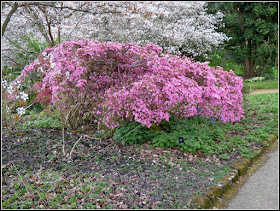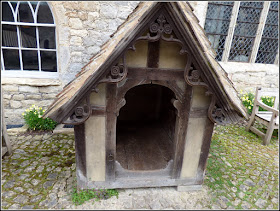This past weekend we stayed two nights in a Bed and Breakfast in the little town of Hawkhurst in the middle of the Kentish Weald, an Area of Outstanding Natural Beauty (AONB). Having in the past driven several times through Kent without stopping, en route to Dover for a ferry crossing to France, we have been meaning to explore this area more thoroughly for a long time.
The Kentish countryside looked lovely - every wood was full of enormous swathes of Bluebells, every bank was full of Primroses, and the trees were speckled with tiny greenish-yellow leaves.
Unfortunately the weather was far from kind to us. In a sense it was typical April weather - sunshine and showers - but it was also
very cold, particularly in the wind. A lot of my photos were taken rather hurriedly because it was too unpleasant to take the time to concentrate on quality! This photo I think summarises quite nicely the sort of weather we had:
If you're wondering what the funny "pointy" building with vents on top are, they are Oasts or Oast-houses. Such things are used for drying hops, a major ingredient of beer. Kent has long been noted for the production of hops, though a lot fewer are grown there these days, and many of the Oasts have been converted to dwelling-houses.
Our main reason for being in Kent at this time was to pick up something (about which I may write on another occasion), but we took the opportunity to turn duty into pleasure, so we gave out National Trust cards a good outing... The first place we visited was Igtham Mote, not far from Sevenoaks.
Igtham Mote is an early 14th Century mansion, progressively re-modelled over the centuries, and includes not only a Tudor façade and a Jacobean staircase, but also some 20th Century additions. I find this sort of place fascinating, because it enables you to get a much better impression of what life was like in days gone by than any book can do. Igtham Mote's name derives from the fact that it is surrounded by a water-filled ditch called a moat. The word "Mote" is an alternative spelling of "Moat".
During Tudor times, the owners of the property were staunch royalists.
They decided to demonstrate their allegiance to King Henry VIII by decorating the ceiling of their chapel with the heraldic arms of Henry and his first wife Katherine of Aragon. This presumably backfired on them when Henry divorced Katherine against the wishes of the pope, and went his own way by founding the Church of England!
If you want more on the history of this property, follow
THIS LINK, but I'm not going to write much about history, I just want to give you an impression of the place through the medium of photography.
This is the first view you get as you approach:
The property is nestled unobtrusively into the countryside, in a place so remote that (allegedly) when Oliver Cromwell sent a troop of soldiers to destroy this "nest of papists" during the Civil War, they couldn't even find it, and the house thus escaped destruction.
This is the main gate-house, access being obtained through the square tower built in the 15th Century:
To the left of the arch (near the drain-pipe) you can see the so-called "Porter's Squint", described as
"a narrow (vertical)
slit in the wall designed to enable a gatekeeper to examine a visitor's credentials before opening the gate."
This is the old stables block.
The property has extensive grounds that you can explore, as well as the more formal gardens:
There was plenty of wildlife to be seen too, though I suspect that this little chap would not have been welcome in the vegetable garden:
This is another of the three entrances to the courtyard.
This is the courtyard inside. The property is unusual in that most of the "interesting bits" face inwards, to the courtyard that is, instead of outwards towards the gardens.
To the right of the photo above you can see a dog-house, Britain's only Grade 1 listed dog-house, built in the 19th Century for a St. Bernard dog called Dido.
Almost every part of the property has been "re-modelled" at some stage. This was once a dove-cote, but since doves are no longer kept, the holes in the front face of it have been made smaller, to accommodate wild birds that wish to nest there.
I'm going to leave you with a photo of another curiosity which may not be familiar to readers from some parts of the world - a "Stumpery":
The
Stumpery was first formally introduced as a fashionable garden feature in the mid 1850s, and soon became very popular with Victorian gardeners with enough room to justify one! Actually, I reckon that in many cases it was probably just that landowners didn't want to pay money for the removal of what was essentially garden rubbish and did a good PR job in persuading people that even old tree-stumps were attractive!
I'll continue, probably tomorrow, to describe our foray into Kent in another post, because after seeing Ightham Mote we went on to visit two more NT properties!

























































